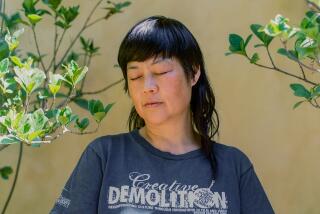Iron-Clad Attitudes
- Share via
Four years ago Patricia Hagerman of Irvine got to thinking seriously about ironing--but not her clothes.
Rather, Hagerman began exploring attitudes about ironing through her art after spotting a stack of old ironing boards in a Santa Ana salvage yard.
“They were so beat up,” she says. “They reminded me of women who’d been dumped and discarded.” Hagerman rescued them, turning the boards into artwork that would serve as a springboard for social commentary.
She plastered one board with drawings of men, labeling it “Too Much Starch.” One board is festooned with butterflies to symbolize the flight and freedom of women from oppressive household duties. She dressed another as a bride with satin gloves and a tulle veil.
“When you get married, you have this view of what it will be like, and often you end up ironing,” she says.
As more people saw her collection, Hagerman found that the ironing boards uncovered memories, emotions and conflicting views about a common household chore. She began to query hundreds of people in Orange County and Los Angeles about ironing, circulating her informal survey at senior centers, clubs and cocktail parties.
People would mill about talking ironing for hours, she said. She discovered that attitudes about ironing often reflected changing attitudes toward women’s roles, housework, the relationship between the sexes and even dear old Mom.
“The survey was revealing,” Hagerman says. “One woman wrote that she used to iron, but her husband never thanked her, so she quit.” Many women said they stopped ironing because nobody appreciated it.
“Some women said they used to iron their husbands’ [boxer] shorts. I would ask them, ‘Why did you do this?’ For most of them, it was wanting approval and acceptance from a male.”
Men also responded to the survey. One said he liked to iron in front of the TV during football games because it relaxed him. Other men strongly stated: “I don’t iron.” One woman told how angry her husband got when she showed her college-age sons how to iron their clothes.
For some men, the sight of an ironing board reminded them of their mothers and sisters.
“They had very fond feelings about the women in their lives who ironed,” Hagerman says.
Still, the most commonly expressed sentiment in the survey was: “Ironing sucks.” One woman wrote: “My thinking about ironing has changed over the years. Now it’s everyone for him/herself.”
That most people hate to iron can be seen in the popularity of so-called wrinkle-free fabrics. In 1993, improved methods of treating cotton fabrics with resin so they resisted wrinkling caused a surge in the marketplace of easy care pants such as Levi’s Dockers and Haggar slacks, followed by wrinkle-resistant shirts.
Yet, according to a study by the International Fabricare Institute in Silver Spring, Md., the wrinkle-resistant fabrics have not made ironing obsolete.
“The shirts were hardly wrinkle resistant, whether they were home or commercially laundered,” the institute reported. People were still bringing in wrinkle resistant khakis to a dry cleaners for finishing.
“Some don’t want to deal with even the little ironing that has to be done,” said Lara Schneider, spokeswoman for the IFI.
That also means that people are ironing their no-iron garments at home.
“We think people don’t iron, but they do,” Hagerman says. “We think we’ve come so far from the past, but we haven’t. It still takes a long time to iron a shirt that’s starched.”
For her, the real question is who’s doing the ironing. Often, she says, it’s the powerless of society.
“Ironing’s changing, but in what way? Many people responded to my survey by saying, ‘Oh, I don’t do the ironing.’ My question is, ‘Then who does?’ It’s usually a low-paid worker or a homemaker.”
She found that many homemakers have either refused to iron for their mates or have found a way to be compensated for the job.
“A lot of women said, ‘If he wants his shirts done, he has to do them himself.’ Some charge their husbands 50 cents a shirt instead of taking them to the cleaners.”
Despite the women’s movement, women still do most of the ironing.
“Just look at the [ironing board] covers they sell. They’re usually ginghamy, with little houses and flowers. The image of women in homes is pretty much the same as it’s always been.”
Working out of her studio in Orange, Hagerman continues to create new boards.
One, called “Security,” is dressed in fancy party clothes. Her “All-American Ironing Board” comes adorned with an American flag and the words “Ironing Sucks.”
Another has the words “ironing” and “planchando” (Spanish for ironing) scrawled all over a red, white and green striped background. “It implies the real ironing is being done mostly by Hispanic women.”
Hagerman first displayed her ironing board art in an exhibit called “Pressing Issues,” held last year at the Satellite Storefront Studio in Irvine.
“At first I didn’t know where I would exhibit them. I mean, no gallery is showing ironing boards,” she says.
She now sells ironing board covers inspired by her art. There’s not a gingham cover in the bunch. One comes festooned with comments from her surveys:
“As an eager young bride, I loved to iron . . . ironing is a necessary evil . . . when I was a young woman I had so little choice in so many things. Now I delight in choosing not to iron unless I really want to.”
Hagerman, too, does not iron unless she really wants to. She learned to iron while growing up in the 1930s and remembers how her mother would come home from working all day to a stack of ironing.
“There was always ironing to be done,” she says.
At age 60, Hagerman only irons when she wants to press fine table linens or a special garment. “If you enjoy beautiful things and you want to iron something, that’s different than doing a load of ironing.”
Like many who responded to her survey, Hagerman just smooths out the wrinkles in her clothes with her hands and frequently works in her sweats, which don’t require ironing.
“I find I wear wrinkled clothes a lot,” she says.
* Patricia Hagerman can be contacted at (714) 633-7014.
More to Read
The biggest entertainment stories
Get our big stories about Hollywood, film, television, music, arts, culture and more right in your inbox as soon as they publish.
You may occasionally receive promotional content from the Los Angeles Times.










